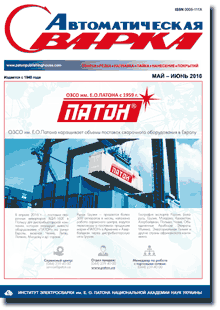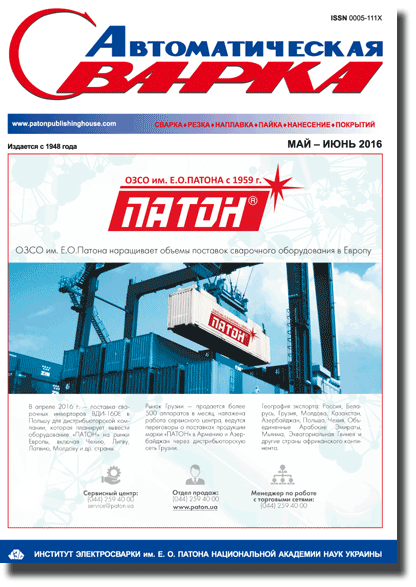| 2016 №06 (26) |
DOI of Article 10.15407/as2016.06.27 |
2016 №06 (28) |

Журнал «Автоматическая сварка», №5-6, 2016, с. 166-172
Resistance welding of coated steel plates in the aspect of environmental conditions
J. Matusiak And J. Wycislik
Institute of Welding 16-18 Str. Bl. Czeslawa, 44-100, Gliwice, Poland. E-mail: joanna.wycislik@is.gliwice.plРеферат
In the industry, resistance welding has always been regarded as the process without significant adverse effect on the work environment. The research literature of the last years dealing with investigations into fume and chemical factors of resistance welding was the only reason that has directed the attention of specialists on working safety to the amount and type of pollutants emitted during this process. The article presents research conducted at Instytut Spawalnictwa in Gliwice, into the emission of pollutants generated during spot resistance welding of steel plates with various protective coatings. The article demonstrates the research station and methodology of determination of total fume, carbon monoxide, nitrogen oxides and organic matters. The examination of fume and gas emission was conducted during resistance welding of electrolytic and hot-dip coated plates, covered with zinc, zinc and iron alloy, aluminium with the admixture of silicon as well as zinc-epoxy double layer coatings. The comparative analysis of the research results was aimed at the determining the impact of coating type and welding current on emission of fumes and gases during resistance welding of plates with different thickness. 17 Ref., 3 Tables, 9 Figures.
Keywords: spot resistance welding, coated steel sheets, pollutants emission
Received 22.03.2016
Подписано в печать 19.05.2006
- Australian Occupational Health and Safety Commission. Welding fumes and gases, 1999.
- Matczak W. Zasady oceny narazenia zawodowego spawaczy / W. Matczak, J.P. Gromiec. — Lodz: Instytut Medycyny Pracy, 2003.
- El-Zein M. Is metal fume fever a determinant of welding related respiratory symptoms and /or increased bronchial responsiveness? / M. El-Zein, C. Infrnte-Rivard // Occupational Environmental Med. — 2005. — № 62. — S. 688–694.
- Legros P. Spot welding fumes: characterization of organic coated steels / P. Legros, P. Lodi. — Arcelor Innovation R&D. Belgium, 2008.
- Carter G. Fume emissions from resistance welding through organic coatings: establishing a method for generating safety data / G. Carter, I. Pengelly. — TWI Report 897/2008.
- Legros P. Research report; resistance welding fumes analysis of coated steels / P. Legros, V. Winne. — Arcelor Research Industry, Gent, 2007.
- Research Report «Fume emissions from resistance welding». — 2002. — TWI.
- Badania emisji zanieczyszczen przy zgrzewaniu rezystancyjnym blach z powlokami. Research report / J. Matusiak, J. Wycislik [et al.] // Instytut Spawalnictwa (Institute of Welding) Bb-105/2010.
- Analiza wplywu warunkow technologicznych innowacyjnych technik spajania roznych materialow konstrukcyjnych z nowoczesnymi powlokami ochronnymi na stan srodowiska pracy. Research report / J. Matusiak, J. Wycislik [et al.] // Instytut Spawalnictwa (Institute of Welding), Ma-34/2011.
- Matusiak J. Ocena zagrozen w srodowisku pracy przy zgrzewaniu rezystancyjnym punktowym, zgrzewaniu tarciowym z mieszaniem materialu zgrzeiny oraz zgrzewaniu ultradzwiekowym i wibracyjnym roznych materialow konstrukcyjnych. Opracowanie zalecen do profilaktyki zagrozen z uwzglednieniem modyfikacji warunkow technologicznych. Zadanie realizowany w 2012. Program wieloletni pn. «Poprawa bezpieczenstwa i warunkow pracy» etap II realizowane w latach 2011–2013 / J. Matusiak, J. Wycislik. — Warszawa: Koordynator CIOP PIB.
- PN-EN ISO 5182:2009: Zgrzewanie rezystancyjne. — Materialy na elektrody i sprzet pomocniczy (oryg.).
- PN-EN ISO 15011-1:2010: Zdrowie i bezpieczenstwo przy spawaniu i procesach pokrewnych. — Metoda laboratoryjna pobierania probek dymu i gazow. Czesc 1: Okreslanie wielkosci emisji dymu podczas spawania lukowego i pobieranie dymu do analizy.
- PN-EN ISO 15011-4:2008/A1:2009: Zdrowie i bezpieczenstwo przy spawaniu i procesach pokrewnych. — Metoda laboratoryjna pobierania probek pylu i gazow. Czesc 4: Karty charakterystyki pylu (oryg.)
- ISO 15011-5:2009: Health and safety in welding and allied processes — Laboratory method for sampling fume and gases. Part 5: Identification of fume and gases generated during welding and cutting through products composed wholly or partly of organic materials.
- ISO 15011-6:2010: Health and safety in welding and allied processes – Laboratory method for sampling fume and gases. Part 6: Procedure for quantitative determination of fume and gases from resistance spot welding.
- Matusiak J. Zgrzewanie rezystancyjne blach stalowych z powlokami a emisja zanieczyszczen do srodowiska pracy / J. Matusiak, J. Wycislik // Biuletyn Instytutu Spawalnictwa. — 2012. — № 3. — S. 20–28.
- Matusiak J. Research into fume and gases emission during resistance welding of coated steels plates / J. Matusiak, J. Wycislik // Hutnik — Wiadomosci hutnicze. — 2012. — № 3. — S. 805–816.
Вартість передплати/замовлення на журнали або окремі статті
| журнал/валюта | річний комплект друкований |
1 прим. друкований |
1 прим. електронний |
одна стаття (pdf) |
| AS/UAH | 1800 грн. | 300 грн. | 300 грн. | 150 грн. |
| AS/USD | 192 $ | 32 $ | 26 $ | 13 $ |
| AS/EUR | 180 € | 30 € | 25 € | 12 € |
| TPWJ/UAH | 7200 грн. | 600 грн. | 600 грн. | 280 грн. |
| TPWJ/USD | 384 $ | 32 $ | 26 $ | 13 $ |
| TPWJ/EUR | 348 € | 29 € | 24 € | 12 € |
| SEM/UAH | 1200 грн. | 300 грн. | 300 грн. | 150 грн. |
| SEM/USD | 128 $ | 32 $ | 26 $ | 13 $ |
| SEM/EUR | 120 € | 30 € | 25 € | 12 € |
| TDNK/UAH | 1200 грн. | 300 грн. | 300 грн. | 150 грн. |
| TDNK/USD | 128 $ | 32 $ | 26 $ | 13 $ |
| TDNK/EUR | 120 € | 30 € | 25 € | 12 € |
AS = «Автоматичне зварювання» - 6 накладів на рік;
TPWJ = «PATON WELDING JOURNAL» - 12 накладів на рік;
SEM = «Сучасна електрометалургія» - 4 наклада на рік;
TDNK = «Технічна діагностика та неруйнівний контроль» - 4 наклада на рік.





